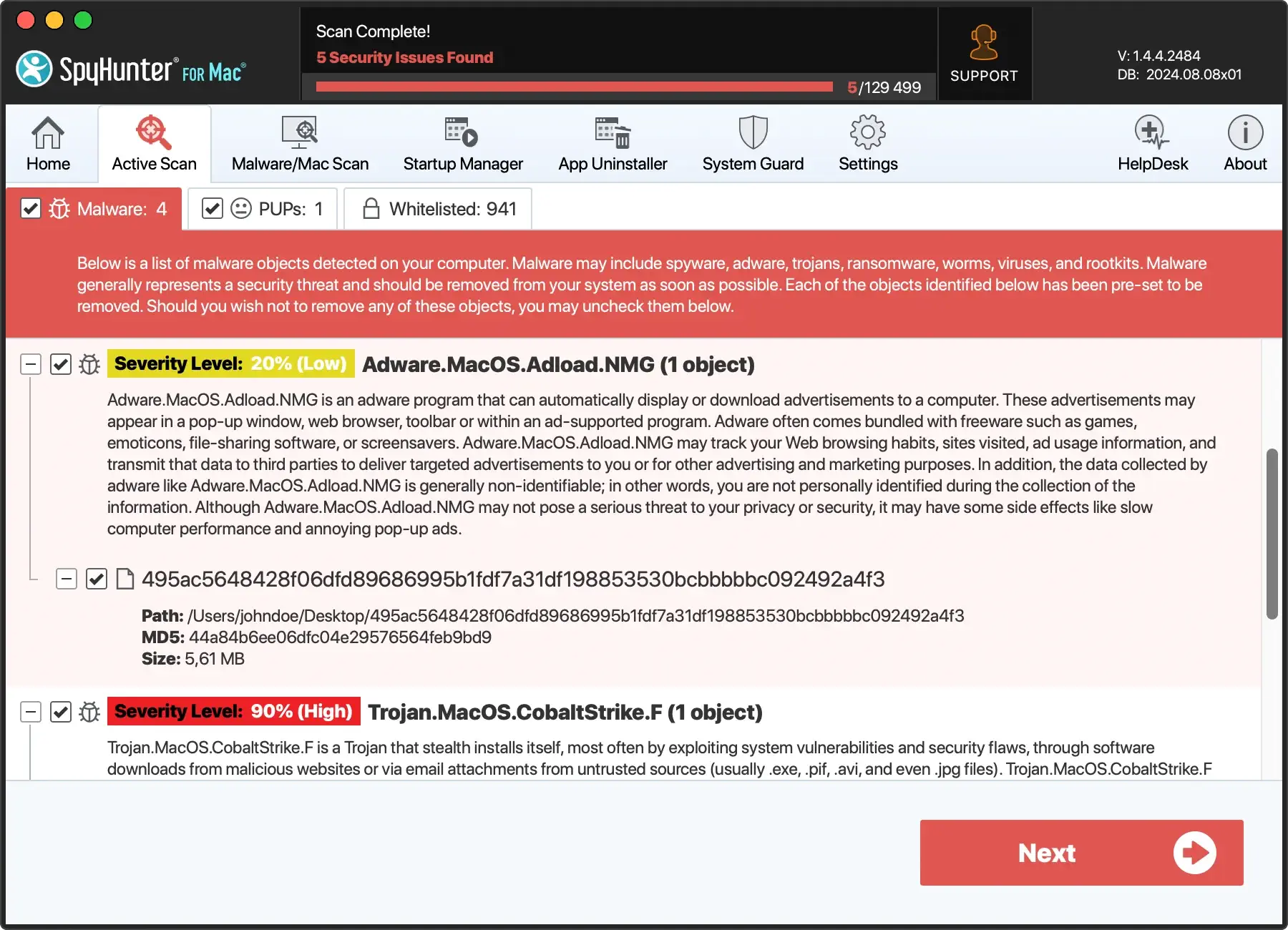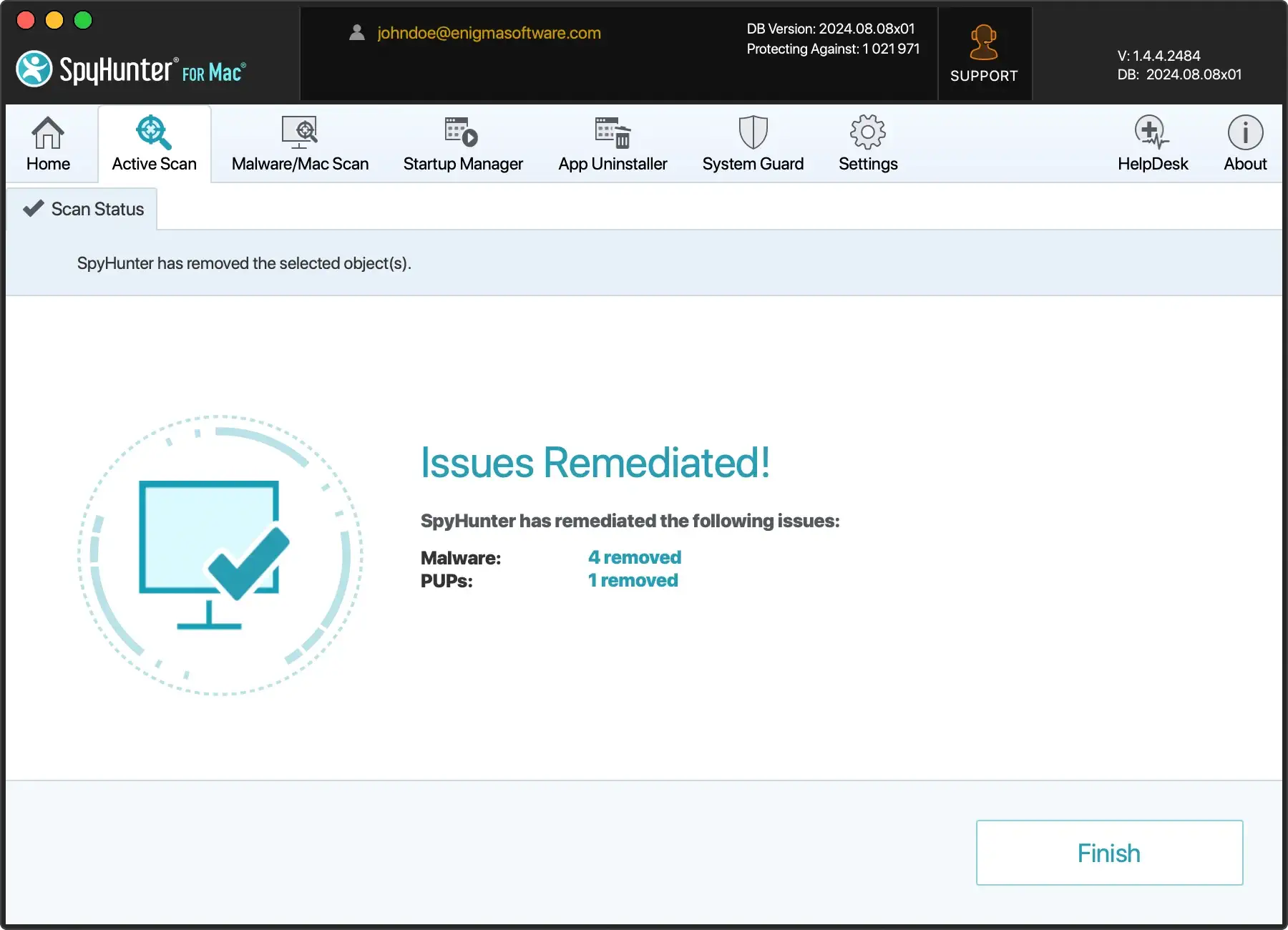‘Your System Is Infected With 3 Viruses’ Pop-Up Scam (Mac)
Before we dive in
Before we dive in, let's make sure you stay safe online. We created SpyHunter because your security matters to us.
Protect your computer today — download SpyHunter right here! Check out our top tips below to keep your computer safe and secure.

Ever stumbled upon a pop-up on a website claiming “Your system is infected with 3 viruses”?
Spotting such alerts can send a shiver down anyone’s spine, making you wonder if your device is truly at risk.
This article looks at the truth behind these alarming messages, revealing their nature as common scams rather than genuine threats. We’ll explore the anatomy of these scams, why engaging with them is a bad idea, and how to efficiently remove them to safeguard your system.
What does the “Your system is infected with 3 viruses” alert mean?
If you’ve encountered a pop-up alert claiming “Your system is infected with 3 viruses,” it’s understandable to feel concerned.
However, it’s crucial to know that this warning is often not a legitimate cybersecurity notification but rather a scam technique.
The message typically appears out of the blue while browsing the internet, and it’s designed to create immediate anxiety. Scammers craft these alerts to mimic the look and feel of genuine warnings from well-known companies.
Yet, the truth is, these pop-ups are aimed at deceiving you into either calling a fraudulent tech support number or downloading harmful software onto your device.

The primary goal behind this scam is to exploit your fear of viruses and malware to manipulate you into taking a specific course of action that benefits the scammers.
Whether that means handing over personal information, allowing remote access to your computer, or making unnecessary payments for “security” services, the end game is to profit at your expense.
Recognizing these alerts as scams is the first step in protecting yourself from potential harm.
Understanding the anatomy of this pop-up scam
At its core, the “Your system is infected with 3 viruses” scam employs a series of psychological tricks to catch people off guard.
The anatomy of this scam includes several key elements designed to maximize impact:
- Alarmist messaging: Phrases like “Urgent: Your device has been hacked” or “Your system is infected with 3 viruses” are designed to evoke panic. This fear compels users to act quickly, often without thinking things through.
- Imitation of legitimate branding: By using logos and visual styles similar to those of renowned companies or antivirus software, the pop-ups gain an air of credibility. This subtlety increases the likelihood of users trusting and acting on the false warnings.
- False urgency: Countdown timers and warnings about imminent damage like “System damage at 28%!” press users into making hasty decisions. The scam relies heavily on this induced urgency to prevent victims from researching or second-guessing the pop-up’s authenticity.
- Deceptive solutions: Links or buttons with calls to action such as “Scan now” or “Install antivirus” are typically present within the pop-up. Clicking such a scam pop up does not resolve any real or imagined issues and often leads to further security risks, such as downloading actual malware.
Understanding these components helps you to identify and dismiss these fraudulent alerts.
Instead of clicking on any provided links or buttons, simply close the tab or browser window. If the browser is frozen or unresponsive, a forced quit might be necessary.
For those who have accidentally interacted with the pop-up or are concerned about potential infections, using legitimate cybersecurity resources or software like SpyHunter for a thorough system scan and malware removal might be warranted.
Why you should not click on “Your system is infected with 3 viruses” alerts
Clicking on alerts claiming “Your system is infected with 3 viruses” is a move that could lead you down a path filled with potential cyber threats.
These fake virus alerts are nothing but a scam to exploit your fears of virus infections. They aim to manipulate you into downloading malware, handing over personal information, or even tricking you into paying for unnecessary software.
The alerts might look convincing with their urgent tone and professional graphics, but they’re designed to deceive. The moment you interact with these alerts, you open the door to real security threats that can compromise your devices and personal data.
Moreover, engaging with these scams could lead to the unintended installation of spyware or other malicious software that could be used to steal sensitive information such as bank details, passwords, and personal identities.
How did the “Your system is infected with 3 viruses” scam reach you?
Understanding how you stumbled upon this scam is crucial in protecting your device and personal information from cyber threats.
Let’s dive into how these deceptive alerts land on your screen.
The usual suspects: How scam alerts infiltrate your system
Scam alerts like “Your system is infected with 3 viruses” often use a blend of sophisticated and traditional tactics to infiltrate your system.
Here are the primary culprits:
- Malvertising: Cybercriminals embed malicious code within online advertisements. These ads appear legitimate but redirect you to scam pages when clicked. Even reputable sites can unwittingly host such ads.
- Misleading websites: Sometimes, browsing a compromised website is enough to trigger these scam alerts. Hackers inject harmful scripts into poorly secured sites, which then generate fake virus warnings.
- Unwanted software: Unintentionally downloading and installing unwanted software, often bundled with legitimate applications, can lead to persistent scam pop-ups. These programs can modify your browser settings to display fake alerts.
- Email phishing: Phishing emails that mimic official correspondence from trusted entities may contain links or attachments that, once opened, expose you to these scams.
Can these alerts harm your computer or steal data?
By themselves, the pop-up alerts warning of 3 viruses cannot directly harm your computer or steal data. The real danger lies in the actions users might be prompted to take after encountering these alerts.
Complying with the instructions, such as clicking on provided links or downloading suggested software, can inadvertently lead to actual security risks.
These might include installing malware, divulging sensitive personal information, or permitting unauthorized access to one’s system.
Therefore, while the alerts are harmless as stand-alone elements, their potency in causing harm is activated when they successfully deceive users into following their misleading advice or instructions.
Dealing with the “Your system is infected with 3 viruses” scam alert
Falling victim to this scam alert can be alarming, but the solution is quite straightforward if you follow these steps.
Here’s a concise guide to help you clear your system of these annoying pop-ups and restore your peace of mind.
- Firstly, quit your browser. If the pop-ups prevent you from doing so, you may need to use force quit by pressing
Command+Option+Esc. This will allow you to close the browser entirely, stopping the scam alert from further interrupting your actions. - Next, disconnect from the internet to prevent any potential malware from communicating with its command and control servers. You can do this by turning off Wi-Fi or unplugging your Ethernet cable.
- Then, run a full system scan using reputable antivirus software. If you don’t already have antivirus software installed, now is a critical time to consider it.
- After the scan, remove any detected threats. This may include malware, adware, or potentially unwanted programs (PUPs) that could be causing the fake virus alerts.
- Finally, clear your browser’s cache and cookies. Malicious scripts stored in your browser could still trigger the fake alerts. Refer to your browser’s help section for instructions on how to clear your browsing data.
By following these steps, you effectively remove any immediate threats posed by the scam alert and reduce the likelihood of future infections.
Using SpyHunter when dealing with scam alerts and potential malware
When it comes to protecting your system from fake virus alerts and other forms of malware, SpyHunter stands out for several reasons.
Its precision in identifying and dealing with a vast array of threats, including the newest malware variants, makes it a robust defense tool.
Moreover, SpyHunter’s malware definitions are updated regularly, which means it can tackle the latest malware threats.
You can download SpyHunter from here and complete the on-screen instructions to install the app.
Once installed, use SpyHunter’s main menu to initiate a full system scan. When the scan is complete, the app will display a list of all malicious or potentially unwanted files found on your Mac.

Use the app’s interface to select and remove any malicious entries found and reboot your Mac if necessary.

SpyHunter’s active guard will ensure your system remains protected against future threats even after you remove any malware discovered in the scan.
How to safeguard your system against pop-up scams and real viruses
Pop-up scams and real viruses pose significant threats to online safety, employing sophisticated tactics to compromise security. To combat these dangers, adopting a multi-layered approach is essential.
Ensure your antivirus is always active and up-to-date, providing a strong first line of defense against malicious software.
Activating pop-up blockers within your browser’s settings can drastically reduce the risk of encountering harmful pop-up scams. These settings are designed to filter out unwanted pop-ups, many of which are crafted to mislead or cause harm.
Additionally, be cautious with links and ads from unknown sources. If a link or an ad seems suspicious or too good to be true, it’s safer to avoid interaction.
Another crucial step is to close any browser windows or tabs that suddenly display alarming messages or unsolicited pop-ups. Engaging with these can lead to malware infections or reveal personal information.
Performing regular system scans is also key to detecting and removing malware early, thereby minimizing potential damage. Keep all software, especially your operating system and applications, updated to patch vulnerabilities that cybercriminals exploit.
By implementing these precautions, you can significantly lower the risk of pop-up scams and virus infections, ensuring a safer online experience.
Best practices in online safety and security
To navigate the internet safely, adopting best security practices is non-negotiable.
Start with a reputable antivirus program to shield against malware. Regular updates for your antivirus ensure it recognizes the latest threats.
Equally vital is keeping your operating system and all applications current, as updates often include critical security patches.
Exercise caution when downloading and installing software. Opt for official sources and custom installation to avoid unintentional additions.
The internet is riddled with seemingly legitimate ads leading to dubious sites. Stay alert to this tactic and manage your clicks judiciously.
Ad blockers and content filters can significantly reduce exposure to risky content, but awareness and mindfulness online are your best allies. Recognize the tricks used in phishing attempts and dubious offers.
Furthermore, regular backups of important data can save you from potential loss due to malware. Strong, unique passwords and the use of two-factor authentication across your accounts will fortify your defenses.
Steering clear of pirated software and dubious downloads is another critical precaution. These often contain hidden malware or lead to security breaches.
By adhering to these best practices, you can substantially enhance your online safety and protect yourself against a wide array of cyber threats.